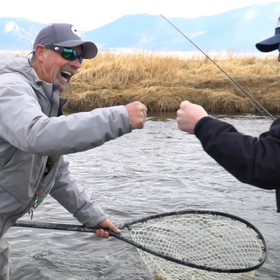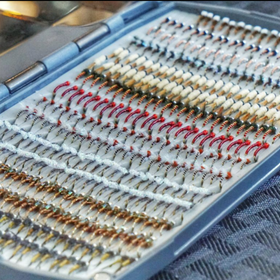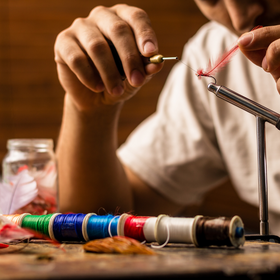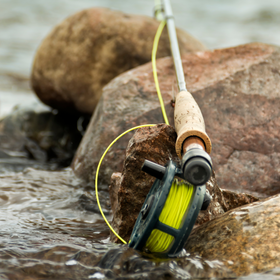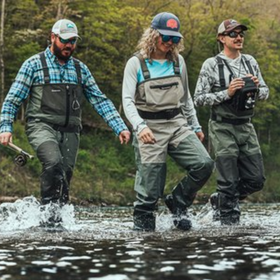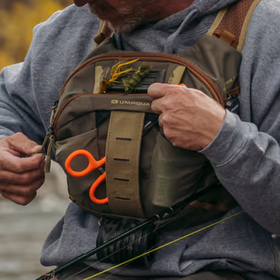Step Up Your Fly Fishing Game with Streamers

By Dick Magill
A good guide is worth their weight in gold. Fly fishing is so much more than a cast, mend, set, and the best guides understand that. They will create an environment that will allow the angler to grow and develop further after each outing.
Streamer fishing is one of the techniques that acts as a great litmus test for a guide. To put it simply, if they are willing to teach you then they are probably a decent guide. If they insist you peg a bead instead because you'll likely catch more fish, you may have wasted a fair amount of time and money. Unless of course, that is what you are into.
Streamer fishing isn't hard. It isn't easy either. It is somewhere in between. It doesn't require the meticulous attention to detail that nymphing does. It's not as beautiful as laying down a size 16 PMD with a perfect drag free drift. Streamer fishing is chaos. It's heart-pounding, adrenaline-pumping chaos – for both you and the fish. A streamer eat from a large predatory fish can and will change your life. People say "the tug is the drug," and if that's true then I've thrown my life away long ago.
Talking to folks who come in and out of the shop, it seems there are two distinct types of anglers when it comes to throwing streamers. The first type of angler is generally a pretty competent nympher who will happily switch to dries if the opportunity presents itself. But if the word streamer is thrown into the conversation, this angler may shy away in self doubt, questioning their ability to wield such a fly. I love talking to these anglers because there is still so much for them to discover about the sport.
The second type of angler is the person who walks through the doors, grabs a spool of 0X fluorocarbon, then makes a b-line over to the streamer section. These anglers are very similar to the first group we talked about with one main difference. At some point along their fly-fishing journey they decided to tie on a large, articulated, beast of a fly and they either caught their largest fish or something close. Absolutely ruining them. I relate to this group as I have had a similar experience and now find myself with a 7wt clutched in my right hand more often than not.
When talking to the first category of anglers, people who are perhaps streamer curious, the first topic I like to go over is gear. Many people don't have a dedicated streamer rod and that's okay. The best rod for any given scenario? The rod you already own. Now, obviously certain weight rods will perform better for this style of fishing than others, but again if a 5wt is all you have, that's fine.
The problem you may encounter with lighter weight rods (i.e. anything 5wt and below) is the ability to throw flies with more mass. Wind resistance is another factor when casting streamers. Take for example Kelly Galloup's Sex Dungeon. Constructed with a deer hair head, this fly can be challenging for novice anglers to cast in the wind. Why fish a fly that may be harder to cast? Well those same properties also allow the fly to move or push water. This ability to aggravate the water stimulates an organ in predatory fish called the lateral line. This organ allows fish to pinpoint their prey even if visibility is less than ideal.
6wts, 7wts, and 8wts are the perfect rod weights for throwing large streamers. Use a 6wt for smaller streamers, 7wt for anything articulated, and an 8wt for anything the size of your hand and larger. When building my personal streamer setup, I landed on a 7wt as it gives me the maximum amount of versatility.
If you decide to build a dedicated streamer set up, I would highly recommend going with either a full-sinking line or some kind of sink-tip line. This not only gets your fly into the strike zone quickly, but also allows for ultra-short 36" leaders that let you swim your fly with all kinds of crazy life-like maneuvers. As for sink rate it all depends on the body of water you fish most often. A full intermediate line that sinks at 1.25" per second is a great choice if you want a sinking line that is slightly easier to cast and fish. The only downside is that you may need to wait longer for your fly to get into the strike zone. If I want a full sinking line I use Scientific Anglers Sonar Triple Density Intermediate/sink3/sink5 line. When looking for a sink-tip line, the Rio Predator in float/sink2/sink4 is hard to beat. The Rio Predator also features a very aggressive weight forward taper design that makes throwing large flies a breeze.
Should you get a dedicated streamer reel for your dedicated streamer rod? Again, that's totally up to you. If you already own a reel that you don't mind swapping the line out when going on a streamer mission then you're good to go. If you do want to secure a dedicated reel for your new streamer rod then I would consider getting a reel with a sealed drag. They are more expensive and they aren't necessarily a requirement in freshwater, but if you do get one then you have made your new streamer rod that much more versatile as now you have a rod suitable for any light saltwater excursion. BONUS!

With rod, reel and line all sorted, the last connection point to your fly will be your leader. There are specific tapered leaders designed for turning over big flies and some people enjoy using them. That's great, I just prefer using a piece of level 0X fluorocarbon tippet. 0X generally has a breaking strength of 13-15lbs. When a large fish smashes your fly at the same time you are imparting action it can cause something called a shock load which drastically reduces the amount of strength your tippet has. If you were using anything lighter than 0X you would risk breaking that fish of a lifetime off before the fight even started. Don't be concerned with the fish not eating your fly because the tippet is "too thick." That is rarely if ever the case when throwing streamers. A fish short swiping your streamer turned off because either the speed, cadence, size, or color of the fly was not correct. It could also be a combination, but I assure you if you figure out those four puzzle pieces then using 0X will never be the reason a big fish didn't eat your fly.
Presentation is more important than fly selection most of the time, but having a cool pattern that swims, kicks, ungulates, and pushes water in a realistic fashion will certainly aid the angler in tricking those monsters lurking in the depths. Take for example Blaine Chocklett's Game Changer series of flies. With life-like segmentation, these flies can move with a hyper realistic swimming motion that predatory fish can't resist. A true game changer in our sport as we now have flies that out fish some of the most prolific lures in the fishing world.
Yet it's not always enough for a streamer to swim well. They must also possess the right color in order to draw fish in as well as trigger them to strike. If it is a bright sunny day I throw either white and gold or white and chartreuse to start. When there is more cloud cover or if I'm fishing close to dawn or dusk I like to fish darker colors like olive, copper, brown, and black. Once the sun goes down I fish black exclusively because it silhouettes against the surface of the water giving fish a better chance of seeing it. Nighttime is also a good time to fish big flies that push a ton of water. This is again due to the fish relying on their lateral line in low visibility scenarios.
With all of our other components dialed in, it's time to discuss the actual fishing of a streamer. You will inherently be making a lot of casts so it is important to make those casts as efficient as possible. Target structure such as boulders, logs, drop offs, or any other ambush point predatory fish can utilize to attack their prey. Cast your fly beyond your target to prevent spooking any lurking fish, then drag your streamer through the strike zone. If you don't elicit a strike on your first pass through it is okay to take several more casts using different retrieves. If I don't see any fish reacting to my fly after several presentations I may consider changing to a different streamer. After tying on a new streamer it's always a good idea to swim it around close to you so that you can see how it moves. Find a movement you think will elicit a strike, then try and replicate that action in the strike zone.
At the end of the day learning a new technique can be a daunting, intimidating affair. Especially when that technique involves throwing large, sharp hooks right by your head. No worries, that's why we're here at The Blue Quill Angler. If streamer fishing is something you think you may enjoy, we will happily show you the way. Be it a conversation in the shop, a casting lesson out back, or a float trip down the Colorado, everyone at the Blue Quill is well versed in what it takes to find success on the water with a streamer and we are more than happy to share that knowledge with anyone willing to learn.


